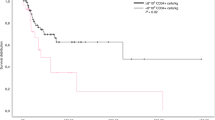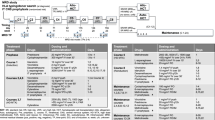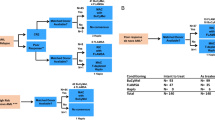Summary:
The 5-year overall survival rate of patients with germ cell tumor (GCT) with poor prognosis, according to the International Germ Cell Cancer Collaborative Group (IGCCCG) classification, is 48% after standard-dose chemotherapy and surgery, if necessary. Two recent studies have showed that early high-dose chemotherapy (HDCT) with hematopoietic progenitor cell support (HPCS) may induce a 2-year overall survival rate of 78% in these patients. We report the long-term results of the experience at the Department of Oncology in Ravenna with early HDCT and HPCS in GCT patients with poor prognosis (IGCCCG criteria). Between 1987 and 2002, 18 poor prognosis GCT patients (17 M, one F), median age 24.5 years (range, 17–52), were treated with early HDCT with HPCS. In total, (67%) patients achieved a complete remission and they are continuously disease-free at a median follow-up of 9.2 years (range, 1.7–16.2). One treatment-related death occurred. No patient developed myelodysplasia or a secondary leukemia. This is notably the longest follow-up reported in patients having received HDCT in this setting. No patient achieving a complete remission relapsed. The role of HDCT in poor prognosis GCT will be defined from the ongoing phase III randomized trials.
This is a preview of subscription content, access via your institution
Access options
Subscribe to this journal
Receive 12 print issues and online access
$259.00 per year
only $21.58 per issue
Buy this article
- Purchase on Springer Link
- Instant access to full article PDF
Prices may be subject to local taxes which are calculated during checkout
Similar content being viewed by others
References
Einhorn LH . Testicular cancer: an oncological success story. Clin Cancer Res 1997; 3: 2630–2632.
Sonneveld DJ, Hoekstra HJ, van Der Graaf WT et al. Improved long term survival of patients with metastatic nonseminomatous testicular germ cell carcinoma in relation to prognostic classification systems during the cisplatin era. Cancer 2001; 91: 1304–1315.
Loehrer PJ, Gonin R, Nichols CR et al. Vinblastine plus ifosfamide plus cisplatin as initial salvage therapy in recurrent germ cell tumor. J Clin Oncol 1998; 16: 2500–2504.
Bosl GJ, Geller NL, Cirrincione C et al. Multivariate analysis of prognostic variables in patients with metastatic testicular cancer. Cancer Res 1983; 43: 3403–3407.
Birch R, Williams S, Cone A et al. Prognostic factors for favorable outcome in disseminated germ-cell tumors. J Clin Oncol 1986; 4: 400–407.
The Medical Research Council Working Party on Testicular Tumours. Prognostic factors in advanced non-seminomatous germ-cell testicular tumours. Results of a multicenter study. Lancet 1985; 1: 8–11.
International Germ Cell Cancer Collaborative Group. International germ cell consensus classification: a prognostic factor-based staging system for metastatic germ cell cancers. J Clin Oncol 1997; 15: 594–603.
Hartmann JT, Nichols CR, Droz JP et al. Prognostic variables for response and outcome in patients with extragonadal germ-cell tumors. Ann Oncol 2002; 13: 1017–1028.
Nichols CR, Williams SD, Loerher PJ et al. Randomized study of cisplatin dose intensity in poor-risk germ cell tumors: a Southeastern Cancer Study Group and Southwest Oncology Group protocol. J Clin Oncol 1991; 9: 1163–1172.
de Wit R, Stoter G, Sleijfer DT et al. Four cycles of BEP versus an alternating regime of PVB and BEP in patients with poor-prognosis metastatic testicular non-seminoma: a randomized study of the EORTC Genitourinary Tract Cancer Cooperative Group. Br J Cancer 1995; 71: 1311–1314.
Kaye SB, Mead GM, Fosså SD et al. Intensive induction-sequential chemotherapy with BOP/VIP-B compared with treatment with BEP/EP for poor prognosis metastatic nonseminomatous germ cell tumor: A randomized Medical Research Council/European Organization for Research and Treatment of Cancer study. J Clin Oncol 1998; 16: 692–701.
De Giorgi U, Rosti G, Papiani G et al. The status of high-dose chemotherapy with hematopoietic stem cell transplantation in patients with germ cell tumor. Haematologica 2002; 87: 95–104.
Dazzi C, Cariello A, Rosti G et al. Peripheral blood progenitor cell (PBPC) mobilization in heavily pretreated patients with germ cell tumors: a report of 34 cases. Bone Marrow Transplant 1999; 23: 529–532.
Miller AB, Hoogstraten B, Staquet M et al. Reporting results of cancer treatment. Cancer 1981; 47: 207–214.
Motzer RJ, Mazumdar M, Bajorin DF et al. High-dose carboplatin, etoposide, and cyclophosphamide with autologous bone marrow transplantation in first-line therapy for patients with poor-risk germ cell tumors. J Clin Oncol 1997; 15: 2546–2552.
Bokemeyer C, Harstrick A, Beyer J et al. The use of dose-intensified chemotherapy in the treatment of metastatic nonseminomatous testicular germ-cell tumours. German testicular Cancer Study Group. Semin Oncol 1998; 25: 24–32.
Kollmannsberger C, Nichols C, Bamberg M et al. First-line high-dose chemotherapy±radiation therapy in patients with metastatic germ-cell cancer and brain metastases. Ann Oncol 2000; 11: 553–559.
Decatris MP, Wilkinson PM, Welch RS et al. High-dose chemotherapy and autologous haematopoietic support in poor risk non-seminomatous germ-cell tumours: an effective first-line therapy with minimal toxicity. Ann Oncol 2000; 11: 427–434.
Hartmann JT, Einhorn L, Nichols CR et al. Second-line chemotherapy in patients with relapsed extragonadal nonseminomatous germ cell tumors: results of an international multicenter analysis. J Clin Oncol 2001; 19: 1641–1648.
Mandanas RA, Saez RA, Epstein RB et al. Long-term results of autologous marrow transplantation for relapsed or refractory male or female germ cell tumors. Bone Marrow Transplant 1998; 21: 569–576.
Rosti G, De Giorgi U, Salvioni R et al. Salvage high-dose chemotherapy in patients with germ cell tumors: an Italian experience with 84 patients. Cancer 2002; 95: 131–137.
Motzer RJ, Mazumdar M, Sheinfeld J et al. Sequential dose-intensive paclitaxel, ifosfamide, carboplatin, and etoposide salvage therapy for germ cell tumor patients. J Clin Oncol 2000; 18: 1173–1180.
Williams SD, Loehrer PJ, Nichols CR et al. Chemotherapy of male and female germ cell tumors. Semin Oncol 1992; 19: 19–23.
Kollmannsberger C, Beyer J, Droz JP et al. Secondary leukemia following high cumulative doses of etoposide in patients treated for advanced germ cell tumors. J Clin Oncol 1998; 16: 3386–3391.
Travis LB, Andersson M, Gospodarowicz M et al. Treatment-associated leukemia following testicular cancer. J Natl Cancer Inst 2000; 14: 1165–1171.
Strumberg D, Brugge S, Korn MW et al. Evaluation of long-term toxicity in patients after cisplatin-based chemotherapy for non-seminomatous testicular cancer. Ann Oncol 2002; 13: 229–236.
Chevreau C, Droz JP, Pico JL et al. Early intensified chemotherapy with autologous bone marrow transplantation in first line treatment of poor risk non-seminomatous germ cell tumours. Preliminary results of a French randomized trial. Eur Urol 1993; 23: 213–218.
Bokemeyer C, Kollmannsberger C, Meisner C et al. First-line high-dose chemotherapy compared with standard-dose PEB/VIP chemotherapy in patients with advanced germ cell tumors: a multivariate and matched-pair analysis. J Clin Oncol 1999; 17: 3450–3456.
Acknowledgements
This work was supported by a grant from Istituto Oncologico Romagnolo for cancer research.
Author information
Authors and Affiliations
Corresponding author
Rights and permissions
About this article
Cite this article
De Giorgi, U., Rosti, G., Papiani, G. et al. Long-term follow-up of patients with poor prognosis germ cell tumor treated with early high-dose chemotherapy with hematopoietic progenitor cell support: a single-center experience. Bone Marrow Transplant 33, 639–643 (2004). https://doi.org/10.1038/sj.bmt.1704397
Received:
Accepted:
Published:
Issue Date:
DOI: https://doi.org/10.1038/sj.bmt.1704397



